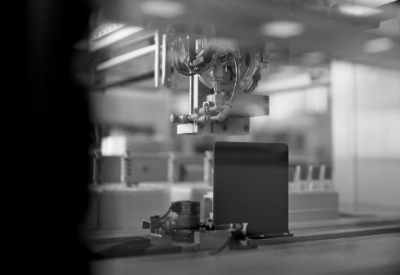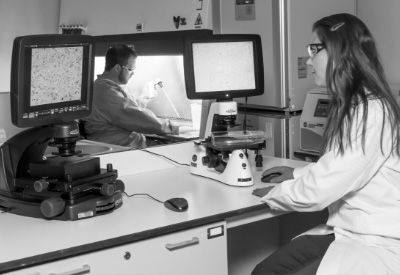
Drillers have always kept records of their endeavors. From the presence and location of certain substances to the depth at which new risks appeared, this information has helped prevent mishaps and attain the desired results for centuries. Understanding drilling mechanisms and strategies allow for more efficient planning.
More recent drills have placed input devices throughout the drillstring[1] [2] to keep track of different metrics. The drillstring includes any tools that make the drill bit turn, such as the drill pipe and bottomhole assembly. Microelectronic devices on the drillstring can be used to gather useful data for guiding drill efforts.
We would like to focus on two categories of drill metrics in particular––measurement while drilling (MWD) and logging while drilling (LWD).
What Is Measurement While Drilling?
Measurement while drilling involves using measurement tools to provide a constant flow of live information on the drill’s position and direction. This information can be used to help steer the drill bit and monitor its pathing.
MWD Logistics
The information gathered from measurement while drilling helps drill operators make informed decisions about where to direct the machine. The primary metrics that will be sent back by an MWD system are inclination and azimuth.
Inclination refers to the drill’s angle relative to a vertical plane and reveals how deep the drill is heading. When the wellbore inclination is 0º, it is completely vertical. In many cases, the inclination will proceed until it’s completely horizontal at 90º.
Azimuth represents the drill’s directional angle relative to North. The azimuth cannot be defined if there is no horizontal movement from the machine. If the drill is moving due North––at any inclination––the azimuth will be 0º. If the wellbore is moving directly East, the azimuth will be 90º, and so on. Beyond the azimuth being undefined at 0º inclination, the two metrics have no further impact on each other because they are measuring separate planes.
MWD Tools Built for Drilling
Measurement while drilling requires placing small input devices in the steering tool of the drillstring at the end of the apparatus. MWD tools—such as magnetometers, accelerometers, gyroscopes, and other devices—work together to gather azimuth and inclination readings. This data is then communicated to the service through mud-pulse telemetry or electromagnetic (EM) telemetry.
Mud-pulse telemetry converts a special fluid that is pumped to the surface into electrical signals. These signals are then converted to ones and zeros, which can be decoded to provide useful information.
Electromagnetic telemetry involves putting an electromagnetic transmitter in the wellbore and sending sinusoidal signals through the ground. A surface system can interpret the signal that is reflected from the transmitter to provide valuable metrics.
All MWD systems must have three parts:
- An input device that measures the surrounding environment
- A transmitter that relays that data to the surface
- A receiver that decodes that data into useful information
Only one type of MWD system will be used at a time, and it’s important to use surface technology that matches the underground technique.
The Importance of MWD
Drilling has become much more of a science than it used to be. Technology is being used worldwide to optimize down-hole drilling operations at every turn. Different embedded devices measure and alter drill paths based on ease and potential reward. Drilling methods have improved significantly and will continue to do so.
Many people in the industry believe that, over time, regulations will become stricter and require additional measurements to be taken during drilling. MWD technology must evolve to meet these standards. Power sources for MWD devices will need to be better suited for down-hole drilling to ensure that accurate information is being supplied.
What Is Logging While Drilling?
Taking a step back from MWD, there is a broader industry expectation of logging while drilling. LWD refers to recording, transmitting, and interpreting a variety of other metrics throughout the drilling process.
Important LWD Metrics
Logging while drilling statistics are reported at regular intervals during a drill operation. These metrics include things like porosity, hole direction, acoustic waveform, resistivity, and pressure being exerted on the drill. Each of these bits of data can help machine operators make decisions in the moment and plan ahead for the next mission.
LWD Tools
Because there are so many different metrics that need to be recorded, many different tool types are used in logging while drilling. Some devices may take snapshots or use gamma rays to interpret their surroundings, others may use pressure sensors or electromagnetic transmitters.
Similar to MWD systems, LWD requires an input device somewhere on the drill, a mechanism to communicate that data to the surface, and a surface system that can decipher the information into something comprehensible. These systems need to be able to function at depth with minimal issues. Inaccurate LWD information could lead to serious problems for the drilling company and the surrounding environment.
The Difference Between Logging While Drilling and Measurement While Drilling
Simply put, MWD is a type of LWD. Keeping logs while drilling can help engineers decide where to place a well and predict the hazards in the area. Updated logging information helps keep drill operations “intelligent,” and leads to more successful operations.
Measurements, on the other hand, pertain more to the specific information used to steer the drill. Real-time metrics relayed to the surface help inform the next move and keep the process running smoothly.
There is a growing need for both forms of data management in the drilling industry.
Remote Devices for Drilling
Building tools for underground or underwater drilling is not the same as regular engineering—there are specific factors that must be considered. Drills often travel very far from rigs into dangerous conditions. It’s not easy to repair a drill that’s hundreds of feet under the surface in a tunnel with minimal (if any) extra space. Not to mention the potential risks of a drill malfunction. Oil spills and other disasters can cause serious environmental damage. These are just some of the reasons drilling operations are monitored so closely.
Drills are built to perform in rough and remote locations, meaning that any additional logging devices must also be well-equipped and up to standard. Resilient and efficient components are a necessity when working to develop devices for down-hole drilling.
City Labs Microelectronic Power Sources for Down-Hole Drilling
Microelectronic devices are already being used to record and transmit signals far below the surface. As drills get deeper, the surrounding environmental conditions get more extreme. Some of these devices––and their power sources––may struggle to perform adequately under such harsh conditions. In response, there will be a growing need for reliable and durable long-term microelectronic batteries.
City Labs has developed low-power NanoTritium™ Batteries which can output a predictable current for more than 20 years. Our products harness betavoltaic power from tritium, which remains consistent under extreme conditions and is relatively benign compared to other isotopes.
The batteries we sell can easily be used to supply energy to MWD and LWD devices such as small power sensors and transmitters that activate periodically.
If you think that our City Labs batteries could contribute to your LWD or MWD efforts, reach out to us today. We are always looking for new commercial and developmental partnerships.
The Nuclear Battery Company With a Vision
Ready to power your next innovation or learn more about our technology?
Contact Us Today



